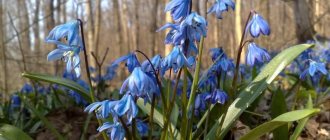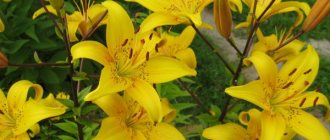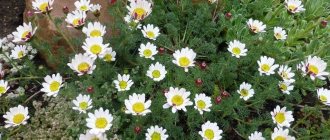Variety of varieties and types of roses
In fact, there is no clear classification of roses; there are only generally accepted groups, according to which these plants are divided if it is necessary to characterize them:
- Shrub
- in some sources you can find another name for them: “park” roses. The peculiarity of this species is its abundant and very long flowering (buds begin to bloom in early June and bloom profusely until late autumn). A high level of frost resistance, disease resistance and low maintenance make this variety of roses especially popular among gardeners. - Peony-shaped
- characterized by abundant flowering and a special bud shape. At the beginning of flowering, the closed buds are spherical in shape; as they bloom, the flowers become cupped. Roses of the Piano variety attract the attention of gardeners by the speed of growth of the bush and its resistance to pests and diseases. - Climbing - all climbing roses can be divided into two types: Rambler and Climber. Rambler bushes are distinguished by thin and graceful stems, which, as the bush grows, may require special supports. The flowers of this species are quite small, small, but they are collected in voluminous inflorescences, each stem is a kind of bouquet. Flowering period is July. This subspecies blooms only once a year. Climber is distinguished by thick and strong shoots; the bush does not require support when growing, but the shoots must be correctly directed to create the correct shape of the bush. This species attracts attention with its long flowering period - all summer and almost all autumn, until the first frost.
- Hybrid is the second name for hybrid tea roses. They are resistant to sudden temperature changes and easily adapt to almost any type of soil. They attract the attention of gardeners with large buds with an abundant number of petals.
Types and classification of roses
It is difficult to classify roses, because there are about 30,000 varieties . The following classification is generally accepted:
- Wild growing (rose hips) . Shrubs, 30 to 200 cm high, weaving or creeping along the ground. Most bloom once with simple flowers. They are undemanding to conditions and care, so they are very popular in summer cottages.
- Vintage park roses . Slender shrubs, up to 1.5 meters high. They have the ability to re-bloom, have a pronounced aroma, and are resistant to diseases. The most famous representatives of this group are Damascus, Gallic, moss, and remontat.
- Modern roses . The result of the painstaking work of breeders, they grow up to 2 meters. This category includes climbing, hybrid tea, miniature, ground cover, scrub and other varieties of roses.
Roses also differ in inflorescences, they can be:
- Densely double (more than 40 petals).
- Medium double (from 30 to 39).
- Moderately terry (from 21 to 29).
- Semi-double (from 8 to 20).
- Simple (from 4 to 7).
It's time to promote our article, in which we have selected some of the best powerful garden pruners. They will be useful to you in caring for your beautiful roses. Choose the best from what we have selected and order on AliExpress.
Varieties of shades and varieties with photos
There are many different colors of roses in nature. Some flowers of this plant received their shade naturally, but through selection (crossing) of different varieties
, and some are the fruits of special care: watering with “colored” solutions, special coloring injections.
Black Baccara (“Black Rose”)
Possessing a special mysterious beauty and attractiveness, the black rose is perhaps the rarest of all that exist in the world. In addition, the plant is a leader in the amount of heavy metal elements it contains.
Despite the fact that the flower seems completely black, it is actually dark burgundy, sparkling in several shades: from black inside the bud to dark crimson on the “edge” of the petals.
For many, the appearance of a black beauty is associated with sadness and mourning and causes great distrust, while others consider this color to be an attribute of grace, harmony and elegance.
Reds
Roses with red buds symbolize passion, love and desire. Breeders around the world call this particular variety of the “prickly queen of flowers” the ancestor of all other varieties. Red roses come in different shades, and the intensity of the color directly depends on the plant variety and the care the plant receives.
Antonia Ridge
It was this bush variety that once became the first “swallow” in the patenting of rose varieties. The flower can reach 1.25 meters in height, it is unpretentious and takes root in any soil. A special feature of the variety is the size of the buds - from 10 to 12 centimeters in diameter.
Black Magic
Large buds can reach 20 centimeters in diameter. The petals of this type of red rose are terry, velvety and have a deep, rich hue.
Rose care
How to care for roses at different times of the year
- In the spring . After the onset of heat, you need to remove the cover from the bushes, carry out spring pruning and fertilizing. If the bushes often suffer from pests, it is worth treating them prophylactically.
- In summer . The most important period is to ensure timely watering, loosen and mulch the soil, and stimulate the flowering of the bush.
- In autumn . The gardener's task is to prepare the roses for winter. Gradually reduce watering and loosening the soil, just weed. They prepare a shelter, do fertilizing and pruning, protect the bushes from rodents by spreading poison.
Planting and fertilization
You need to plant seedlings after waiting for the weather to warm up. Roses are moisture-loving plants; they are watered abundantly in the morning or evening, preventing the roots from being washed away.
The bushes are watered every day until they are completely rooted, and then 2 times a week. Fertilizer is placed in a trench or hole for planting. Subsequently, the plant is periodically fed with organic and mineral fertilizers.
An excess of minerals can lead to petrification of the soil and inhibition of plant growth. Every month it is necessary to loosen and mulch the soil under the bush; with the onset of cold weather, the soil is compacted.
Pruning roses
When planting in spring, seedlings are pruned in advance. In the first summer, buds are removed from the bush for proper plant development. It is important not to touch the leaves - they are necessary for photosynthesis.
There are three ways to trim:
- 4 buds from the base of the stem . Used to rejuvenate bushes, stimulate the growth of frail plants and newly acquired seedlings.
- 7 buds from the base . During the flowering period, garden roses become more magnificent.
- Trimming the ends of the stems . This method is used to stimulate the bush to flower as quickly as possible.
Important! The frequency of pruning depends on the type of rose: hybrid tea, floribunda are pruned annually. For scrub roses and ramblers, shoots are shortened by a third by cutting out the branches inside the bush. Only five-year-old shoots of climbing roses are removed
Sheltering roses for the winter
With the arrival of night frosts, the rose is covered with a mixture of peat, earth and sand in equal parts. The height of the resulting mound should be at least 25-30 cm. The bush is pruned, shoots that have not yet matured are removed, and the frequency of watering is reduced. The top of the bushes is covered with cardboard, spruce branches, and film. Sometimes special fabrics are used - agrotex, lutrasil. When snow falls, you need to form a snow mound on top of the shelter - this is additional protection from wind and frost.
The shoots of branched roses are shortened and bent to the ground, with a film laid down to protect them from dampness. You can wrap the bush with the same film - then spruce branches will not be needed. With the onset of spring, the top film is removed first, and the bottom film is removed when the earth warms up thoroughly.
For more information about planting, pruning and caring for roses, watch this video:
Yellow
Yellow roses can more often be seen in the front gardens of gardeners-collectors than in bouquets. After all, belief says that buds of this color are harbingers of separation and lost love.
Sunstar
The sunny rose Sunstar has a particularly bright shade of buds. The flowers are large, up to 15 centimeters in diameter, the petals have a soft apricot accent.
Yellow Rose of Texas
The small, dense buds of the Yellow Rose of Texas variety have a deep yellow tint when closed. But when the rose opens, the petals lose their brightness and the flowers take on a delicate honey-pink hue.
The best bush varieties of roses
A bush variety is a group of medium-shaped roses that have bright colors and a pleasant scent. They reveal delicate shades and can be orange, pink, white or red. Each variety is easily accepted into the soil, grows quickly, and gives beautiful flowering. They can be planted in triangular, rectangular, square ridges. The variety is not picky in care, tolerant to frost, high sun or wind.
Queen of Sweden
Discreet, cold beauty has a delicate pink tint, ideal shape, and thick petals. The diameter of the flower does not exceed 8 cm, opens deeply, and has a round shape. The petals do not bend, they always look up even when exposed to harsh sun or rain. They are considered resistant to different weather conditions, fit perfectly with other varieties, and are relatively small in size. The aroma is persistent, but not pronounced, and is revealed to a greater extent under the influence of sunlight. The bush is up to 1 meter wide, the leaves are not large and require regular processing.
Advantages
- Beautiful view;
- Delicate scent;
- Easy to care for;
- Sustainability;
- Flowers open well.
Flaws
- It needs to be watered regularly.
Queen of Sweden has a rather delicate shade, a desaturated aroma, resistant to different weather conditions. Its small size and volume allow you to quickly and conveniently care for it, regularly cutting off unnecessary branches.
Princess Margaret
“Princess Margarita” has a beautiful orange color, single, large buds that steadily maintain their condition and do not crumble even under the influence of the environment. They have a pleasant smell that lasts for a long time. Flowering is abundant and does not stop even in the off season. The bush is erect, has penetrating branches, and is covered with light green foliage. It has increased resistance to diseases and does not deform when insects or aggressive raindrops hit it. It grows in bushes, one branch can bear up to 15 buds.
Advantages
- Soft color;
- Beautiful view;
- Persistent odor;
- Easy to care for;
- Fast adhesion to soil.
Flaws
- It is important to trim branches regularly.
Reviews show that with proper care and increased attention to the branch, it retains a beautiful appearance, the leaves do not crumble, and they are not affected by a negative environment. The bud retains its condition for up to a month, then they may crumble a little.
White
White roses symbolize youth, purity and tenderness. Bouquets containing buds of this color are given mainly to young girls and young brides for weddings.
Schneewittchen
The name of the variety in German sounds like “Snow White”, which already perfectly characterizes the shade of the flowers of this rose. The birthplace of this variety is China, and the ancestor is considered to be the Chinese variety “White banksia (banksia)”. Large, semi-double buds amaze with their sparkling whiteness and regularity of lines. This variety of white rose
It is also famous for one feature - its flowers do not smell.
Snowflake
A special feature of this variety is its small milky-white buds with many double petals. The flowers exude a sweet aroma with notes of apple.
Diseases and pests of roses
Pests are most dangerous during the growing season of bushes. The most common are: roseate scale insects and aphids , various types of sawflies , chafer beetles , spider mites , caterpillars , slobbering pennies , gallworms . They suck out the juice and infect young buds, leaves and shoots.
Signs of rose damage:
- The leaves dry out or curl into a tube.
- Plant growth slows down.
- Young shoots wither.
- The leaves turn yellow, a sticky coating and cobwebs appear on them.
- Spots (yellow, serous, etc.) appear that quickly increase in size.
The proliferation of pests is facilitated by high temperature, poor plant care (neglect of soil mulching and hilling, lack of insecticidal prophylaxis).
Description and treatment of rose diseases
The most common diseases of roses:
- Powdery mildew . A fungal disease that manifests itself by the appearance of a white coating on the shoots of the bush. The leaves begin to curl, turn yellow and fall off. The affected leaves should be removed and burned, the plant should be sprayed with iron sulfate (300 g of vitriol per 10 liters of water) or a copper-soap mixture (100 g of soap and 50 g of vitriol per 10 liters of water).
- Black spot . The causative agent of the disease is a fungus. The leaves become covered with dark brown spots, the edges turn yellow. The flower buds do not bloom and fall off. For treatment, you need to treat the bush with a 0.1% solution of foundationazole, phytosporin and alirin.
- Rust . Appears in April-May in young plants. Orange-yellow tubercles appear on the shoots and leaves. Affected leaves fall off and shoots dry out. Affected stems should be cut off and burned. Treat with a copper-soap solution or wormwood decoction.
- Gray rot . A fungal disease that affects the stems and leaves - they have a characteristic fluffy coating. The buds begin to rot, the leaves fall off. The affected shoots are removed, and the rose is treated with a copper-soap emulsion or a 0.2% solution of foundationazole.
Important! Most fungi develop in damp and rainy weather. Also, the appearance of the disease contributes to too much watering of plants.
Excellent video about treating rose diseases:
How to treat roses against pests
To eradicate pests, it is necessary to carry out 2-3 treatments with an interval of 3 days. Insecticides of contact or systemic action are used: Fundazol, Fufanon, Aktara, Aktellik, Fitosporin and others. Copper-soap emulsion, soap-kerosene solution (for 10 liters of water, 300 ml of kerosene and 100 g of soap), decoctions of garlic and tobacco also help. Caterpillars and beetles must be removed manually; branches affected by small pests should be cut off and burned.
Black
It’s worth clarifying right away: black roses are a myth; such varieties do not exist. Simply conventionally, “black” refers to buds of deep shades, purple and burgundy.
Black Baccara
The buds of this flower have a beautiful shade as close as possible to black, but still it is a burgundy rose. A special feature of the Black Baccara variety is the absence of sharp thorns.
Black Magic
The buds of the Black Magic rose have a deep dark crimson color, due to the fact that the flowers are double, the shade appears black. The peculiarity of the variety is its “longevity”; the flowers retain their freshness
within 2 weeks after cutting.
The best varieties of climbing roses
Varieties of climbing flowering roses are planted mainly in summer cottages and in the courtyards of country houses, as they require constant care in the form of tying, pruning, and weeding. The length of the shoots can reach up to 5 meters. Most tolerate winter well, resistant to high frosts, wind or scorching sun. They do not need shelter, despite the fact that they are quite sensitive to powdery mildew.
Pink pearl
An unusual, bright flower can be grown either in the form of a low climber or in the form of an arched, large scrub. The petals have a rich apricot color and can fade to a creamy shade. They bloom beautifully and create a light, delicate scent that cannot be compared with the scent of other varieties. The leaves are resistant to diseases, bacteria and cobwebs do not form on them, they remain shiny, large and healthy all the time. Flowering continues all summer and autumn, it complements walls and pillars, creating a beautiful interior around. Before planting plants, it is advisable to dig up the soil and also add sand or humus to it, which will additionally saturate it with useful components for growth and stable flowering. Leaves and bushes require regular pruning; for this you need to use pruners of different lengths and volumes, and also know all the intricacies of plant growth.
Advantages
- Unusual appearance;
- Full flowering;
- Light odor;
- Disease resistance;
- Withstands temperature changes well.
Flaws
- Leaves and bushes need to be trimmed regularly.
Such varieties of climbing roses, which bloom all summer, require attention and regular care. They will take root only in prepared soil, which is previously saturated with humus or sand. You can use a special universal fertilizer for flowers, which will also saturate the soil with useful components.
New Dawn
New Dawn is a re-blooming variety that combines beautiful flowering and a pleasant scent. It can withstand frost and does not require special attention when caring. Even an inexperienced gardener who is just beginning to learn the secrets of growing roses can grow such a plant. The petals have a pearly pink color, a delicate shade that lasts until the first frost. The bush can have a height of up to 250 cm, its leaves are not susceptible to diseases, they do not take on cobwebs, and easily fight small insects. The flowers have a soft, fragrant smell, which is not characteristic of most plants. Under the influence of the sun, the petals transform into white without losing their beauty and richness.
Advantages
- Mild smell;
- Good height;
- Volumetric buds;
- Resistance to frost and sun;
- Minimal care.
Flaws
- Not detected.
New Dawn is easy to care for, guarantees beautiful flowering, and suits any garden design. Even an inexperienced gardener who does not know all the features and secrets of planting can grow such flowers.
The best pumps to increase water pressure
Sympathy
Climbing “Sympathy” was bred in 1964 by the famous breeder Wilhelm Cordes. It has a bright red tint with a slight crimson tint. There are up to 10 medium-sized flowers on the stem. The aroma is not intense, but persistent, gentle, relaxed. The average flower size is up to 10 cm, its height is 4.5 m, and its width is 2 m. The “Sympathy” variety is resistant to frost, dew, rain or sun. It also does not take on the negative effects of insects and cobwebs. To avoid deterioration in appearance, the plant must be regularly cared for, treated with special products, and watered. The optimal time for planting is considered to be autumn and spring.
Advantages
- Good smell;
- Blooms quickly;
- Frost resistance;
- Easily tolerates the sun;
- Easy to care for.
Flaws
- Not detected.
The climbing rose requires care, but is quite resistant to temperature changes. It retains its beauty and pleasant smell for a long time, the leaves do not lose their color and are not affected by insects.
Greens
Roses with green buds are a real miracle of selection. But such flowers are short-lived and require special care.
St. Patrick's Day
The most popular variety among green roses is St. Patrick's Day. The elongated beautiful buds with double petals have a rich green color when closed, and light green when open.
Cream
Cream-colored roses are quite popular among gardeners; also, thanks to the delicate shade of baked milk, the buds of this variety are often used by florists when creating wedding arrangements.
Bella Perla
The rose variety Bella Perla has beautiful goblet buds. The peculiarity of the flowers is their soft pink border of the petals and long stem.
Recommendations for choosing rose varieties for different regions
Among the many hybrids of this beautiful plant, there are those that are able to survive in the most difficult conditions.
For Siberia and the Urals
Among the popular varieties grown in the difficult climatic conditions of the North, the best varieties of roses for Siberia are distinguished:
- Rosarium Uetersen is a variety of climbing roses, often grown as a standard. Tolerates winter, wind and frost. Resistant to fungi.
- Solero – floribunda rose. Has good immunity and frost resistance.
- Lemon Rokoko is a floribunda rose variety. Resistant to frost and disease.
- John Cabot - climbing rose. Withstands temperatures (-35) degrees.
For the Urals:
- New Dawn is a climbing rose. Winter-hardy. There are varieties that bloom all season.
- Golden Selebration is one of Austin's finest. They survive in the coldest climates.
- Westerland is a climbing rose of Cardes, which is used as a bush rose. Growing quickly. Tolerates harsh winters.
Recommendations for choosing rose varieties for different regions
The best varieties of Canadian roses for Siberia and the Urals:
- Morden Gentennial;
- Morden Blush;
- Henry Hudson;
- Martin Frobisher.
For the middle band
The best varieties of roses for central Russia:
- Lawrence Johnston;
- Baltimore Belle;
- Mermaid;
- Bobby James;
- Flammentanz.
Varieties for the Moscow region must be frost-resistant:
- New Dawn;
- Gloria Day;
- Hello;
- Sympathie;
- Sea Foam;
- Leonardo de Vinci.
New varieties of roses for the garden, terrace, balcony
Over the past 30 years, there has been a real revolution in rose breeding. A well-known manufacturer, the company Kordes, whose varieties are very popular (Westerland, Lichtkönigin Lucia, Schneewittchen, Friesia, Rosarium Uetersen), decided to take a bold step in the late 1980s. On test fields, he completely abandoned the use of plant protection products. Only 10 percent of the bushes survived the experiment! And although the result should dampen the enthusiasm of the breeder, it was these few varieties that remained in good condition that gave birth to an entirely new generation of roses.
Thanks to this risky experiment, today we can enjoy exceptionally healthy varieties, very resistant to diseases, fighting fungal diseases on their own. Caring for and planting such plants is simple. Examples of new varieties are given below.
For balconies, terraces
Small shrub or miniature varieties develop well and bloom beautifully in pots on the terrace or balcony. You can note:
- Weg der Sinne;
- Innociencia;
- Gärtnerfreude;
- Solero;
- Sonnenröschen;
- Bassino.
Multifloral
They winter well, have a compact bush shape, and are suitable for group plantings - flower beds, decorating paths. Resistant varieties:
- Gebrüder Grimm;
- Apricola;
- Cherry Girl;
- Roter Drache;
- Cubana;
- Planten un Blomen;
- Rotilia;
- Black Forest Rose;
- Kosmos.
What varieties of roses to choose for planting in the Urals
The Urals, compared to the Moscow region, have a rather harsh climate. Of course, I would like to grow southern varieties, but it is still better to purchase them from local nurseries. These varieties are already acclimatized and growing them will not present any difficulties.
One popular variety is New Dawn.
In addition to the fact that this variety is very winter-hardy and unpretentious, it is also prickly. However, very fragrant. This variety has varieties, some of which bloom throughout the season, while others bloom once.
Rosarium Western
This is a winter-hardy variety with good immunity to disease.
The flowers are dark pink, up to 12 cm in diameter. Shoots can grow up to 3 m. Often used for sale in the form of bouquets.
Golden Celebration
A very beautiful plant with large yellow flowers. The bushes grow up to 1.5 m. They amaze with their unusual aroma. Caramel smell, like a candy factory. Surely many will like it.
In addition to these climbing roses, there are several more varieties recommended specifically for the Urals.
Flamentanz
It blooms once with deep red double buds for 30-35 days.
The bush is spreading, reaches up to 2.5 m. It is winter-hardy and disease-resistant.
Super Excelsa
Blooms repeatedly with bright crimson flowers.
The bush is spreading and can be used for growing on arches. Winter-hardy, also tolerates heat well.
Ground cover roses
This group includes creeping shrubs with densely leafy long shoots (up to 4 m) that densely cover the soil. Flowers can be simple, double or semi-double, small or medium. Most groundcover varieties are characterized by long and abundant flowering. Such plants do not require special care and are resistant to fungal diseases.
Ground cover roses are used for landscaping slopes and creating standard weeping roses.
Varieties and hybrids: Alba Meian, Basi, Gold Carpet, Ondela, Snow Ballet, Suney, Fairy.
Polyantha roses
On low, dense and heavily branched bushes in mid-July, many small roses (up to 6 cm in diameter) bloom, collected in inflorescences of 20-100 flowers. They can be either simple or terry.
Polyantha roses bloom until late autumn; their cut flowers can last up to 15 days. The color can be white, pink, red, orange. Polyanthus roses are also distinguished by the fact that they have almost no thorns.
In the middle zone, the bushes of these roses require light shelter. They can also be grown in the Urals and Siberia.
Polyantha roses are most often used in group plantings and borders, and some short varieties (for example, Mutertag and Dick Koster) are suitable for growing in containers.
Varieties and hybrids: Border King, Gloria Mundi, Yvonne Rabier, Cameo, Orange Triumph.
Park roses
This group includes ancient roses, including decorative rose hips. As the name implies, such plants are often used for landscaping parks and gardens; they look great both in single and group plantings. Park roses are winter-hardy, rarely get sick and are not very picky about caring for them. They often decorate flower beds on city streets.
These roses bloom early and abundantly, but they bloom for a short time and only once per season. However, the rich aroma exuded by these flowers is truly intoxicating.
In decorative varieties of park roses, the flowers reach 10 cm in diameter, they are single or collected in inflorescences of 3-6 pieces. The leaves are large, leathery, wrinkled. The height of a wide and dense bush is usually 1-2 m.
This group includes wrinkled rose (rugosa).
Varieties and hybrids: Grotendorst, Pink Grotendorst, Ritausma.
Miniature roses
This is a small copy of garden roses. Densely leafy bushes up to 40 cm high with small double flowers of a wide variety of colors (from greenish to purple) are often grown indoors. Here roses can bloom almost continuously all year round. And in open ground, miniature roses bloom from May to late autumn and require light shelter for the winter.
Miniature roses look great in rocky hills, rock gardens and borders, and they are also used to create boutonnieres to decorate hairstyles or festive outfits.
Varieties and hybrids: Baby Masquerade, Denise Cassegrain, Hummingbird, Mandarin, Stars and Stripes, Zwergkening.
Rose Floribunda
These roses were obtained by crossing with varieties characterized by large buds. The palette of colors is particularly wide, including various yellow shades. Floribunda roses are very popular due to their brightness, tones, resistance to disease, and weather conditions. They are most widely used to add bright colors to garden space and for cutting. The most popular Floribunda roses are the varieties Edelweiss, Friesia, and Montana.











